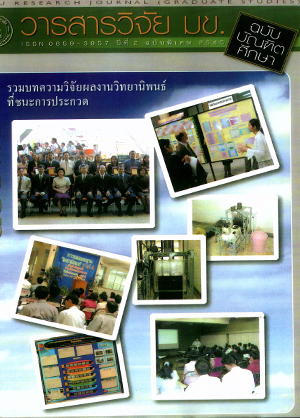Effects of Antioxidants on Thiols Status and nitric Oxide Metabolism in Hemolytic Anemic Rats (ผลของสารต้านออกซิเดชันต่อสถานภาพธัยออลและเมแทบอลิซึมของไนตริกออกไซด์ในหนูขาวทดลองฮีโมลับติคอะนีเมีย)
Keywords:
Antioxidants, Hemolytic Anemia, Vitamin E, TironAbstract
The aim of the present study was to determine whether the two antioxidant candidates (vitamin E and tiron) could protect against the oxidative damage and improve the circulatory status in rat-treated with Phenylhydrazine (PHZ). Male Sprague-Dawley rats were randomly divided into 8 groups with 8-10 animals per group. The animals in these groups were intraperitoneally injected with receiving substances for 7 days; Groups 1and 2 vitamin E 25 and 50 mg/kg/day; Groups 3, 4 and 5-tiron 100, 250 and 500 mg/kg/day; Groups 6 and 7 solvents. On the fifth day of treatments, all animals studied were induced hemolytic anemia by a single peritoneal injection of 125 mg/kg PHZ. The control rats (Group 8) were injected with 0.9% NaCl for 7 days. Results showed that both antioxidants reduced the toxic effects of PHZ and improved the circulatory status. Moreover, the antioxidant effects of vitamin E (50 mg /kg /day) and tiron (250 and 500 mg/kg/day) were found to be associated with an enhancement in blood level of GSH and reduction s in plasma levels of MDA, NOx and GSNO (P<0.001). In conclusion, the present results demonstrated that treatments of vitamin E and tiron could not only decrease free radical s and ROS production s, but also ameliorate the consequent effects of PHZ. Therefore, a potential application of antioxidant treatment as an adjunct therapy under hemolytic anemic condition is an important indication and should be further explored.



